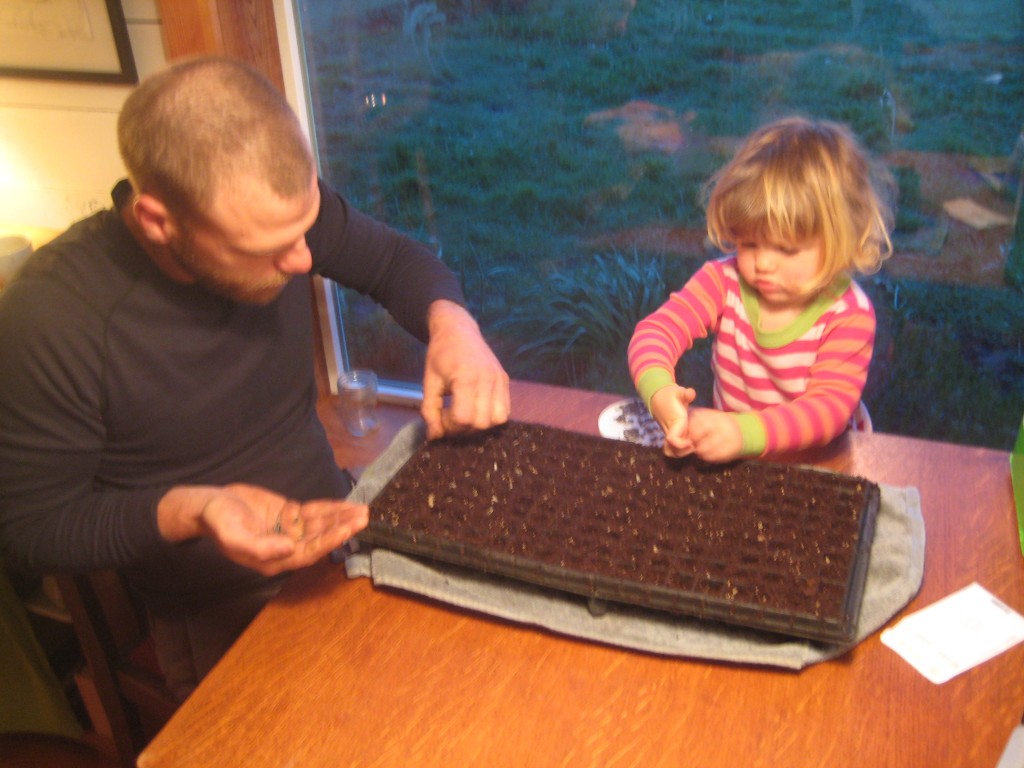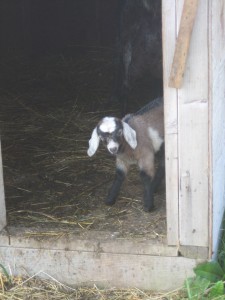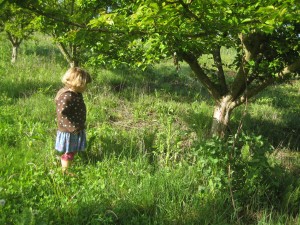This morning brought fun activity on the farm. First of all, a slightly sick Dottie awoke for the day at 5 am (too early!), so — ever the creative farm father that he is — Casey suggested that she help him sow some sunflowers. Before breakfast. And, so it happened!
At breakfast itself, we found ourselves all staring out the window to watch our goats. All but one had come out of their shed to graze, and given that two does were due today we wondered if that meant the last one was inside with babies. Eventually we confirmed that hunch through binoculars, and later in person. Our first kids born on the farm! (Besides our own, that is!)
Um, by the way, goat kids are seriously cute. Like, ridiculously floppy, adorable, over-the-top CUTE.
So, now we’ve got two kids on the farm (besides our own!) and a doe in milk, with more on the way.
Which begs the question of why we have goats. I mean the answer is obvious: goats are awesome, and goat milk is amazing. Yes, really — I’m sorry for you if you’ve never had good goat milk, but trust me that good goat milk exists, and it is divine — just hard to come by. Our family is totally hooked on goat milk everything — yogurt, cheese, milk (in coffee — heaven).
When we purchased these goats last fall, the idea was to transition from being an “exempt” raw cow milk dairy to a licensed raw goat milk dairy. We had lots of really fun conversations with our local ODA inspector about how to make this dream a reality, including continuing our favored practice of milking on fresh pasture every day (very clean!). Amazingly enough, the ODA was game and was willing to work through tricky logistics with us. Between all of us, we had some pretty good plans in place.
In the meantime, we dried off our cows and goats (who we’d been milking just for our own family at that point) — and for the first time in two and a half years, we had no active dairy component to our farm. No daily milking. No big routine of cleaning all the milking equipment. No employees on the farm seven days a week.
I’ll tell you what: it has felt really good to take a break. And, in that time, the farm has really turned a (very positive!) corner in our profitability. The years that we operated our dairy and our prior “Full Diet” CSA program (an older manifestation of what we’re doing at the storefront now) were pretty lean years around here in every sense. We always felt pinched for time and money. Thankfully we had many years of farming before those years to know that our farm does not have to feel that way!
So, we made some big and little changes, and today we are so glad. Our days have more breathing room in every sense. Smiles come easier. This precocious spring has certainly helped too (have you looked at the forecast for the coming week? Wowza, it’s going to be awesome here in the Willamette Valley).
One of the lessons for us from recent years is that we really can’t do everything out here. We can do a lot, but adding additional enterprises can often add stress without adding much profitability. Given that our family depends on the farm for our full livelihood (and have done so since the first year! Hoorah!), basic profitability is not negotiable!
Which brings us back to goat milk. Goats are awesome. Goat milk is awesome. But, but, but — with a farm that’s grooving along happily this spring, we question whether re-adding a micro dairy component to our already very diverse offerings would re-add more stress to our days and budgets. Dairying is hard. We have deep and profound respect for the farmers who make their livelihood this way, committed to their animals and dairies for decades. It’s a type of farming with little to no built-in rest. We bow to you dairy men and women.
Tomorrow Casey plans to go out to milk Belle. Our family will enjoy her milk. But the plan beyond that is still up in the air. Sell milk under the exempt raw milk laws here on the farm? Maybe? Or just keep these goats for the farm — possibly. The next few days and weeks may help clarify.
It’s clear though that we want to sustain what we have gained out here with some of 2015’s changes — all that breathing room is just too wonderful to give up (and of course the main summer growing season itself will take up some of it!). What does that breathing room give us? It means that today — the middle of our busy work week — Casey got to host a tour for a class of Chemeketa students, helping explain to them how and why we grow our food organically. It means that even though Casey works seven days a week right now (because of animal chores on the weekend), we get very quiet weekend afternoons to hang out, work on house projects and inoculate mushroom logs. It means that I can focus more of my days on being with our kids, helping them to grow and learn through the methods we enjoy best (such as taking walks around the field to harvest and building stick tipis on a sunny afternoon!).
I definitely don’t want to suggest that our days are all carefree idyllic sunshine around here. We still work plenty hard! Oh boy! But there is a sense of space around all that work that brings great pleasure into to our daily purpose. At the end of 2012, Casey and I both had some close scrapes with our health, and it gave a renewed sense of urgency to live now. To not defer enjoyment, because tomorrow may just not be. And, we love this work. When we have the space to enjoy it, it brings great, deep joy to our days.
So, we’re pondering still. For the most part, we understand and love the shape of our farm and where it is headed this year and beyond. But then there are these goats and their milk. Something to ponder.
But you know what we don’t doubt? At all? The awesomeness of vegetables. This time of year is traditionally the leanest for annual vegetables — as the storage and over-wintered crops begin to run out but the spring planted crops aren’t quite ready yet. We keep bracing for what we call “the pinch point,” but then the list of CSA items flows from Casey’s pen like magic. We call it “alchemy,” because honestly it is hard to see the abundance this time of year (except in the greenhouses!). But even though the volume of hay and stored veggies are reduced from their full fall glory, they are still here. The over-wintered crops are still pumping out new leaves. The fields are providing. Living so intimately with these miracles is a heady thing, my friends. An overwhelmingly amazing and awesome experience. Alchemy.
Enjoy this week’s vegetables!
Your farmers, Katie & Casey Kulla
~ ~ ~
Meet this week’s vegetables:
- Head lettuce — Thank you to our greenhouses for this extra special treat!
- Salad/chicory mix — This salad mix features all kinds of greens from our fields, including chicories (relatives of radicchio), rapini, kale and parsley. We recommend chopping this fine and dressing it with a mild or sweet dressing.
- Chard
- Kale & mustards — These are mixed bunches of greenhouse kale and mustard greens. They can be cooked together with delicious results. The mustards will taste slightly spicy when raw (although these are relatively mild), but the spice mellows out with cooking.
- Stinging nettles
- Celery leaf
- Parsley — This week’s share offers two very unique opportunities for making pesto. First, you can use garlic and walnuts from this week’s share for either preparation, but then you have to choose your green: nettles or parsley? Both are amazing, but they have very distinct flavors. Process your chosen green with olive oil, walnuts and garlic (salting to taste). Eat on everything!
- Kohlrabi
- Potatoes
- Beets
- Green garlic
- Garlic
- Apples
- Walnuts — If you haven’t tried our walnuts yet, here’s a great opportunity! These are English walnuts and they have a great sweet flavor. They also have a fun special feature — you can open [most of them] with just your fingers! They twist open! This makes them extra fun treats to eat with kids. Ask us to demonstrate at pick-up.
- Eggs
And this week’s extra goodies from the farm: Remember to bring containers when appropriate! Especially for eggs!
- Corn flour — $5 lb
- Oat flour — $5 lb
- Walnuts — $5 lb
- Sauerkraut — More traditional cabbage sauerkraut. $5 / pint or $3 / half pint (our jars are $1 each, but you can bring your own).
- Eggs — $4 dozen
- Pork cuts — We’ve got chops, ground pork, pork belly, and lots of roasts! Prices vary.
- Pork fat & skin — $3 lb
- Lamb — Prices vary. We’ve got all kinds of delicious roasts! If you want a special treat to feed a crowd, try buying one of our deboned legs of lambs.
- Ground beef — $7 for 1 lb package







Another wonderful read, Katie!
Just wanted to let you know! The Swedish Meatballs I had made using the 1lb Beef and 1lb Pork purchased was absolutely AMAZING!